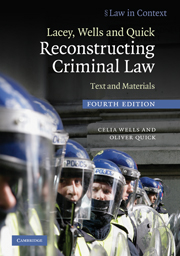Book contents
- Frontmatter
- Contents
- Preface
- Table of cases
- Table of statutes
- Section I Approaching Criminal Law
- Section II Law, Order and Security
- Section III Interpersonal Violence; Drugs and Alcohol Abuse; Offence Preparation and Participation
- 8 Offences Against the Person
- 9 Drug and Alcohol Abuse
- 10 Offence Preparation and Participation
- Section IV Property and Propriety
- Section V Regulating Sexuality and Bodily autonomy
- Section VI Making a Killing
- Bibliography
- Index
- References
8 - Offences Against the Person
from Section III - Interpersonal Violence; Drugs and Alcohol Abuse; Offence Preparation and Participation
Published online by Cambridge University Press: 05 June 2012
- Frontmatter
- Contents
- Preface
- Table of cases
- Table of statutes
- Section I Approaching Criminal Law
- Section II Law, Order and Security
- Section III Interpersonal Violence; Drugs and Alcohol Abuse; Offence Preparation and Participation
- 8 Offences Against the Person
- 9 Drug and Alcohol Abuse
- 10 Offence Preparation and Participation
- Section IV Property and Propriety
- Section V Regulating Sexuality and Bodily autonomy
- Section VI Making a Killing
- Bibliography
- Index
- References
Summary
It is useful to place interpersonal violence in the context of crime levels as a whole. The Home Office annual report on crime refers to the British Crime Survey (BCS) and to crime recorded by the police:
Home Office 2009 Crime in England and Wales 2008/9
Summary of the main findings
The majority of crimes are property related.
• Vandalism accounts for 26% of all BCS crime (two-thirds of which is vehicle vandalism); criminal damage accounts for one in five (20%) of crimes recorded by the police.
• Vehicle-related theft accounts for 14% of all BCS crime. Offences against vehicles account for 13% of recorded crime.
• Burglary accounts for 7% of all BCS crime and 12% of recorded crime. Violent crime represents around a fifth (20%) of BCS crime. Violence against the person also accounts around a fifth (19%) of police recorded crime.
We focus here on assault and battery, and on the three main general offences under the Offences against the Person Act 1861: actual bodily harm (s. 47), malicious wounding (s. 20), and causing grievous bodily harm with intent (s. 18). The somewhat imperfect hierarchy of the 1861 Act reflects both differences in the seriousness of injury or harm and in the mental element. The government initially endorsed the codified set of offences based on the Law Commission's proposals in Report No 218 (1993) but as yet no legislation has been introduced (Home Office 1998).
- Type
- Chapter
- Information
- Lacey, Wells and Quick Reconstructing Criminal LawText and Materials, pp. 233 - 267Publisher: Cambridge University PressPrint publication year: 2010



